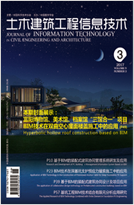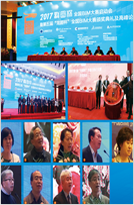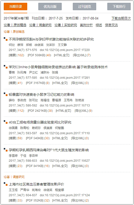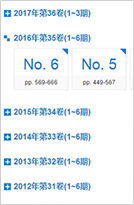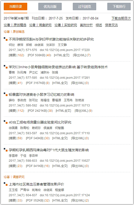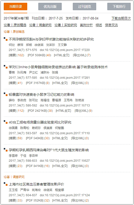2019, 11(6): 113-121. doi: 10.16670/j.cnki.cn11-5823/tu.2019.06.18
基于Airpak的办公室热环境数值模拟分析
华东建筑设计研究院有限公司, 上海 200041 |
Numerical Simulation and Analysis on Office Thermal Environment by Using Airpak
East China Architectural Design & Research Institute Co., Ltd., Shanghai 200041, China |
引用本文:
贡欣, 蒋琴华. 基于Airpak的办公室热环境数值模拟分析[J]. 土木建筑工程信息技术,
2019, 11(6): 113-121.
doi: 10.16670/j.cnki.cn11-5823/tu.2019.06.18

Citation:
Gong Xin, Jiang Qinhua. Numerical Simulation and Analysis on Office Thermal Environment by Using Airpak[J]. Journal of Information Technologyin Civil Engineering and Architecture,
2019, 11(6): 113-121.
doi: 10.16670/j.cnki.cn11-5823/tu.2019.06.18

摘要:建立了基于Airpak的VRV加新风空调系统模型和一次回风空调系统模型,模拟得到夏季两种工况下的室内气流的温度场、速度场分布状况,并采用PMV-PPD及空气龄等指标对室内人员热舒适性及空气品质进行评价,结果表明两种方案工作区的风速均能达到舒适性空调的要求,人员无明显吹风感,一次回风空调系统相比VRV加新风空调系统:气流扰动较小,人员呼吸区温度波动较小,新鲜空气能够及时送达,室内空气品质较好
Abstract: This paper establishes models of the VRV & fresh air conditioning system and the primary return air conditioning system by using the software of Airpak, to simulate the temperature field and velocity field distribution of indoor air flow under two conditions in summer, and then to evaluate indoor thermal comfort and air quality by adopting the indexes like PMV-PPD and air age. Results show that both the wind speed of two schemes can meet the requirements of comfort air conditioning, without obvious sense of blowing for people. Compared with the VRV & fresh air conditioning system, the primary return air conditioning system has smaller air flow disturbance, smaller temperature fluctuation in respiratory area, and better indoor air quality with timely delivered fresh air.
| [1] |
周怀改.通风对建筑物室内污染物浓度分布的影响[D].重庆大学, 2007. |
| [2] |
刘彩霞, 邹声华, 杨如辉.基于Airpak的室内空气品质分析[J].制冷与空调(四川), 2012(4): 381-384. |
| [3] |
黄寿元, 赵伏军, 李刚.基于Airpak的夏季空调室内热环境数值模拟研究[J].湖南科技大学学报(自然科学版), 2011, 26(2): 11-17. |
| [4] |
陆耀庆.实用供热空调设计手册[M].中国建筑工业出版社, 1993. |
| [5] |
Fang T, Feng H, Wu B.Indoor Ventilation Simulation in Green Building Based on Airpak[C]//International Conference on Computer Distributed Control and Intelligent Environmental Monitoring.IEEE Computer Society, 2011, 848-851. |
| [6] |
Alonso M J, Andresen T, Frydenlund F, et al.Improvements of air flow distribution in a freezing tunnel using Airpak[J].Annales Geophysicae, 2011, 1(2): 1231-1238. |
| [7] |
狄育慧, 徐子龙, 邓保顺.火车站候车厅不同回风形式的热环境研究[J].西安建筑科技大学学报自然科学版, 2014, 46(5): 742-748. |
| [8] |
Liu X N, Shen J, Yang Y A, et al.Application of the Software Airpak on the Design of the Air-conditioning Train[J].Journal of Tianjin University of Commerce, 2004. |
| [9] |
Di Y H, Wang S C.Error analysis of simulation of indoor airflow organizations with Airpak[J].Xian Jianzhu Keji Daxue Xuebao/journal of Xian University of Architecture & Technology, 2013, 45(1): 73-78. |
| [10] |
吴珊.北方农村被动式住宅通风换气技术研究[D].2016. |
| [11] |
WHO guidelines for indoor air quality: selected pollutants[M].Bonn Office: WHO Regional Office for Europe, 2010. |
| [12] |
ASHRAE 62.1-2007 Ventilation for Acceptable Indoor Air Quality[S]. |
| [13] |
杨阳, 曹小林, 何凯, 等.室内空气品质评价指标和方法简述[J].流体机械, 2014(12): 73-76.doi: 10.3969/j.issn.1005-0329.2014.12.016 |
| [14] |
中华人民共和国建设部.采暖通风与空气调节设计规范: GB50019-2003[S].北京: 中国计划出版社, 2004. |
| [15] |
向璐, 厚彩琴, 李振华, 等.上置式置换通风模式的数值模拟及其性能分析[J].甘肃科学学报, 2017(6): 81-88. |
| [16] |
向璐.毛细管顶板辐射与置换通风复合空调系统作用下室内热环境的数值研究[D].兰州理工大学, 2017. |
计量
- PDF下载量(30)
- 文章访问量(2501)
- HTML全文浏览量(1212)



